Enterprise Resource Planning (ERP) Report: Nestle and PG&E Analysis
VerifiedAdded on 2022/12/26
|21
|4848
|57
Report
AI Summary
This report provides a comprehensive overview of Enterprise Resource Planning (ERP), a crucial business software management process. It begins by introducing the concept of ERP and its importance in modern organizations, illustrated through case studies of Nestle and PG&E. The report highlights the benefits of ERP, such as improved efficiency, better resource management, and enhanced decision-making, referencing Nestle's successful implementation. Conversely, it discusses the failures encountered by PG&E due to improper ERP implementation. Furthermore, the report delves into the ongoing evolution of ERP, including the emergence of mobile, social, and cloud-based systems. It also outlines the stages involved in ERP processing, from planning and discovery to deployment, and the benefits and barriers associated with each stage. The report concludes by emphasizing the critical role of ERP in maintaining a competitive edge in today's dynamic business environment.
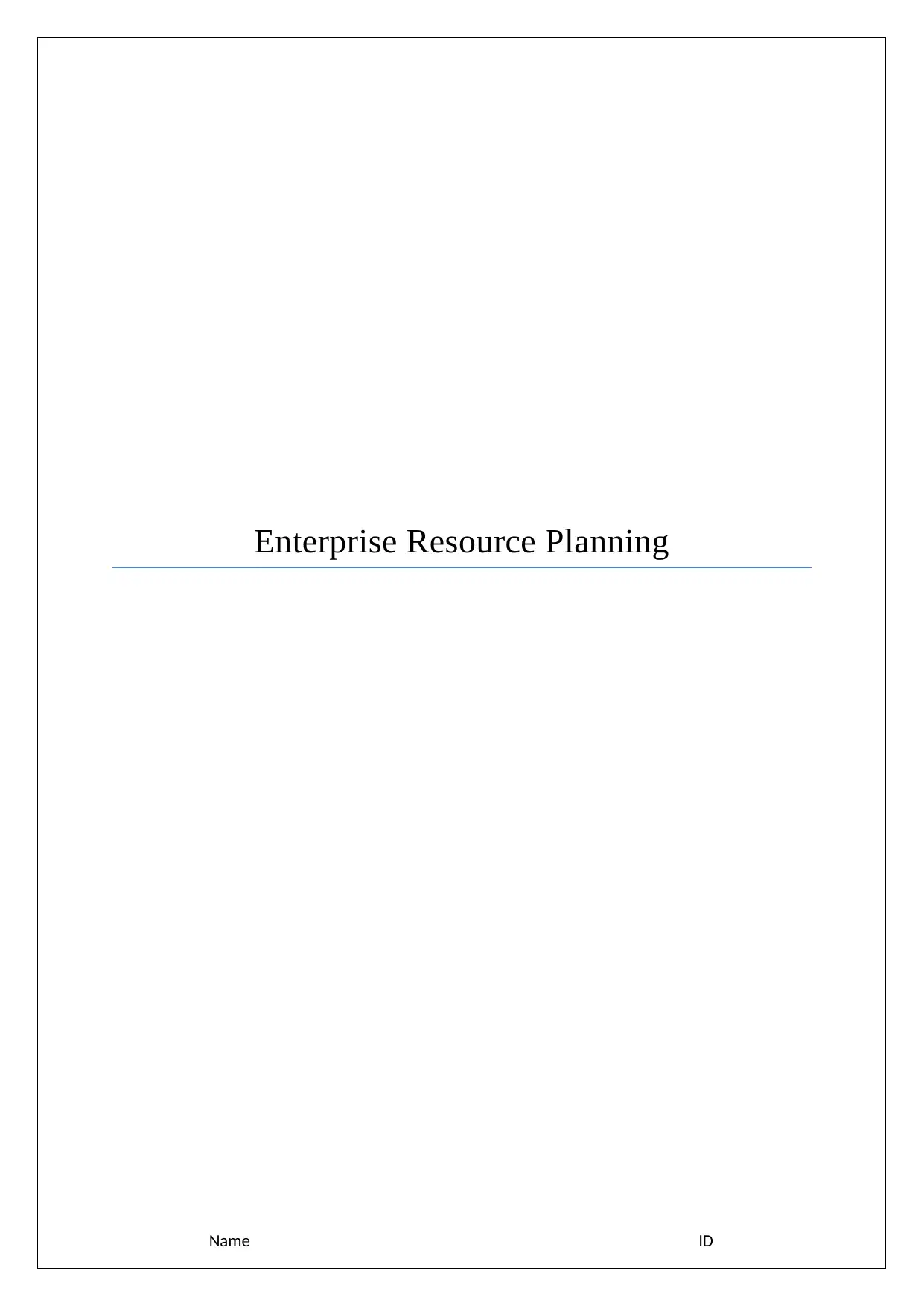
Enterprise Resource Planning
Name ID
Name ID
Paraphrase This Document
Need a fresh take? Get an instant paraphrase of this document with our AI Paraphraser
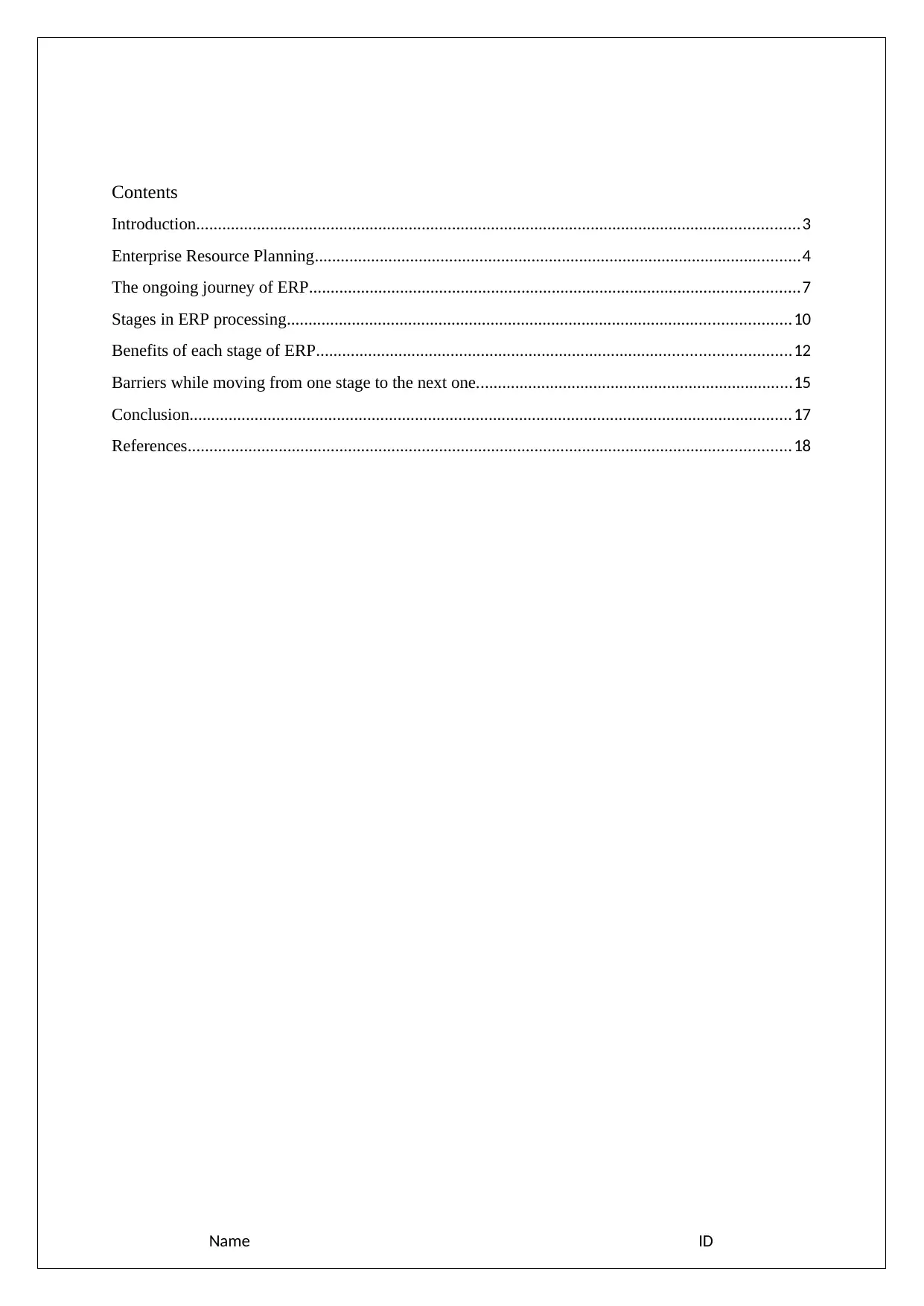
Contents
Introduction...........................................................................................................................................3
Enterprise Resource Planning................................................................................................................4
The ongoing journey of ERP.................................................................................................................7
Stages in ERP processing....................................................................................................................10
Benefits of each stage of ERP.............................................................................................................12
Barriers while moving from one stage to the next one.........................................................................15
Conclusion...........................................................................................................................................17
References...........................................................................................................................................18
Name ID
Introduction...........................................................................................................................................3
Enterprise Resource Planning................................................................................................................4
The ongoing journey of ERP.................................................................................................................7
Stages in ERP processing....................................................................................................................10
Benefits of each stage of ERP.............................................................................................................12
Barriers while moving from one stage to the next one.........................................................................15
Conclusion...........................................................................................................................................17
References...........................................................................................................................................18
Name ID
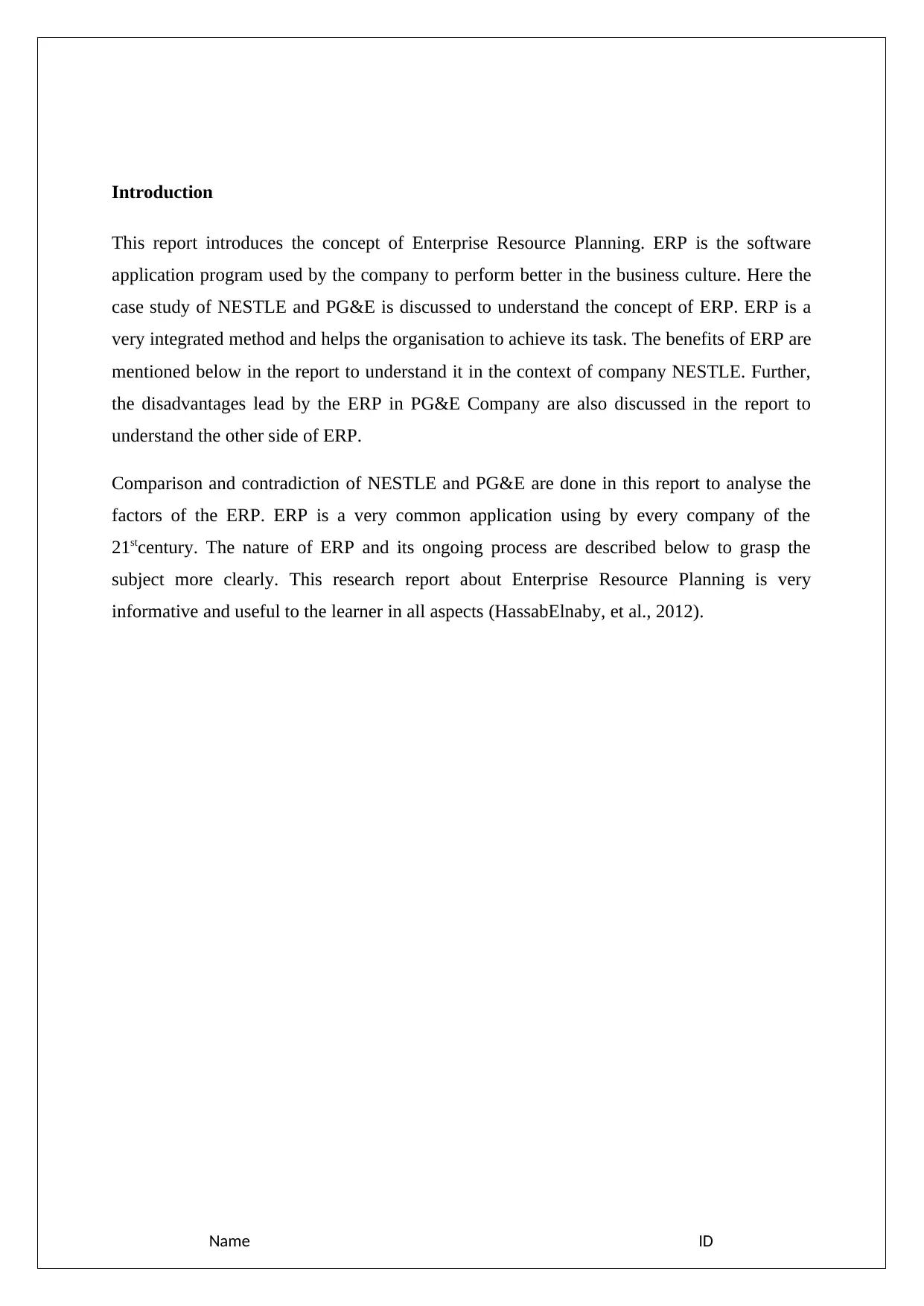
Introduction
This report introduces the concept of Enterprise Resource Planning. ERP is the software
application program used by the company to perform better in the business culture. Here the
case study of NESTLE and PG&E is discussed to understand the concept of ERP. ERP is a
very integrated method and helps the organisation to achieve its task. The benefits of ERP are
mentioned below in the report to understand it in the context of company NESTLE. Further,
the disadvantages lead by the ERP in PG&E Company are also discussed in the report to
understand the other side of ERP.
Comparison and contradiction of NESTLE and PG&E are done in this report to analyse the
factors of the ERP. ERP is a very common application using by every company of the
21stcentury. The nature of ERP and its ongoing process are described below to grasp the
subject more clearly. This research report about Enterprise Resource Planning is very
informative and useful to the learner in all aspects (HassabElnaby, et al., 2012).
Name ID
This report introduces the concept of Enterprise Resource Planning. ERP is the software
application program used by the company to perform better in the business culture. Here the
case study of NESTLE and PG&E is discussed to understand the concept of ERP. ERP is a
very integrated method and helps the organisation to achieve its task. The benefits of ERP are
mentioned below in the report to understand it in the context of company NESTLE. Further,
the disadvantages lead by the ERP in PG&E Company are also discussed in the report to
understand the other side of ERP.
Comparison and contradiction of NESTLE and PG&E are done in this report to analyse the
factors of the ERP. ERP is a very common application using by every company of the
21stcentury. The nature of ERP and its ongoing process are described below to grasp the
subject more clearly. This research report about Enterprise Resource Planning is very
informative and useful to the learner in all aspects (HassabElnaby, et al., 2012).
Name ID
⊘ This is a preview!⊘
Do you want full access?
Subscribe today to unlock all pages.

Trusted by 1+ million students worldwide
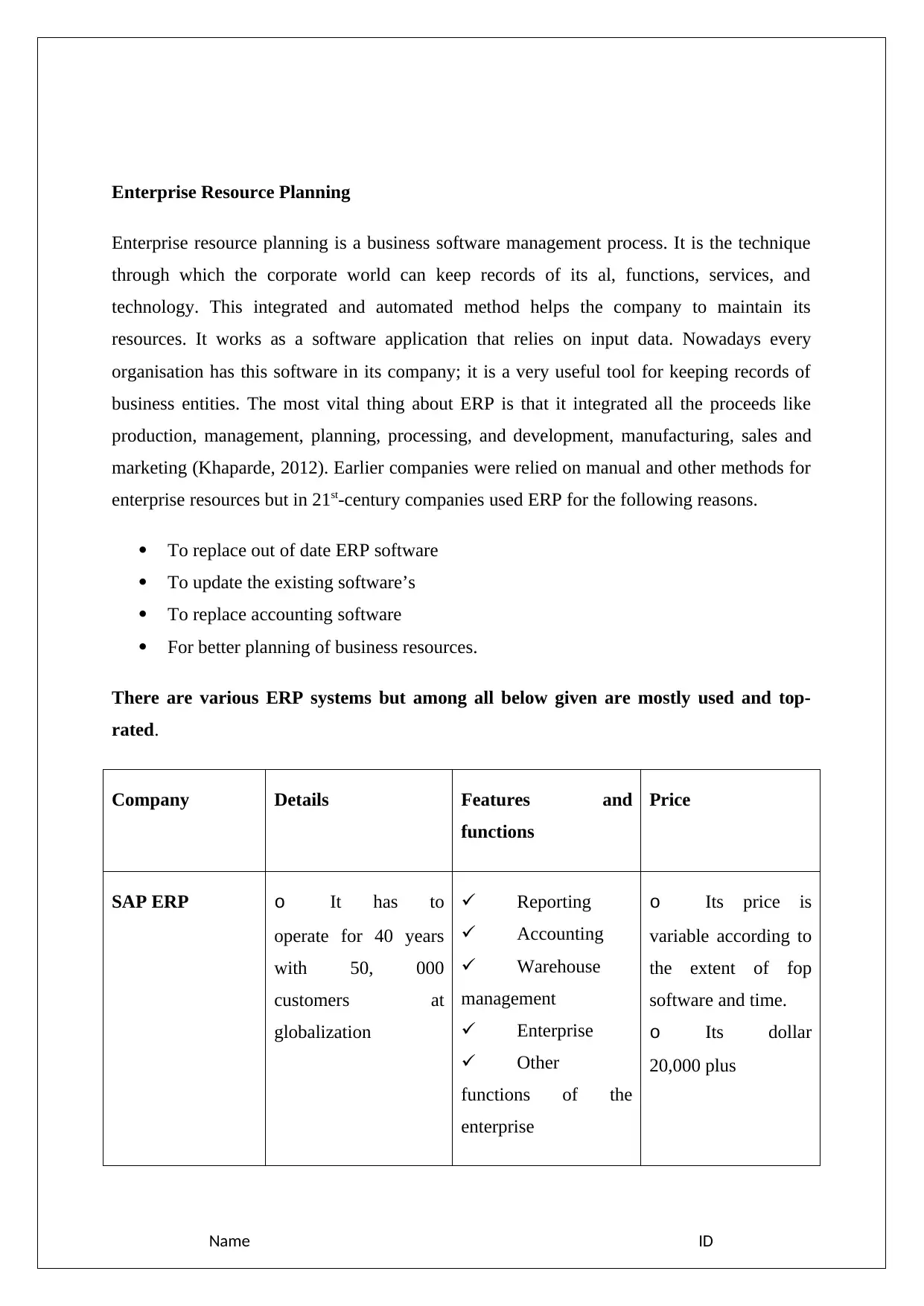
Enterprise Resource Planning
Enterprise resource planning is a business software management process. It is the technique
through which the corporate world can keep records of its al, functions, services, and
technology. This integrated and automated method helps the company to maintain its
resources. It works as a software application that relies on input data. Nowadays every
organisation has this software in its company; it is a very useful tool for keeping records of
business entities. The most vital thing about ERP is that it integrated all the proceeds like
production, management, planning, processing, and development, manufacturing, sales and
marketing (Khaparde, 2012). Earlier companies were relied on manual and other methods for
enterprise resources but in 21st-century companies used ERP for the following reasons.
To replace out of date ERP software
To update the existing software’s
To replace accounting software
For better planning of business resources.
There are various ERP systems but among all below given are mostly used and top-
rated.
Company Details Features and
functions
Price
SAP ERP o It has to
operate for 40 years
with 50, 000
customers at
globalization
Reporting
Accounting
Warehouse
management
Enterprise
Other
functions of the
enterprise
o Its price is
variable according to
the extent of fop
software and time.
o Its dollar
20,000 plus
Name ID
Enterprise resource planning is a business software management process. It is the technique
through which the corporate world can keep records of its al, functions, services, and
technology. This integrated and automated method helps the company to maintain its
resources. It works as a software application that relies on input data. Nowadays every
organisation has this software in its company; it is a very useful tool for keeping records of
business entities. The most vital thing about ERP is that it integrated all the proceeds like
production, management, planning, processing, and development, manufacturing, sales and
marketing (Khaparde, 2012). Earlier companies were relied on manual and other methods for
enterprise resources but in 21st-century companies used ERP for the following reasons.
To replace out of date ERP software
To update the existing software’s
To replace accounting software
For better planning of business resources.
There are various ERP systems but among all below given are mostly used and top-
rated.
Company Details Features and
functions
Price
SAP ERP o It has to
operate for 40 years
with 50, 000
customers at
globalization
Reporting
Accounting
Warehouse
management
Enterprise
Other
functions of the
enterprise
o Its price is
variable according to
the extent of fop
software and time.
o Its dollar
20,000 plus
Name ID
Paraphrase This Document
Need a fresh take? Get an instant paraphrase of this document with our AI Paraphraser
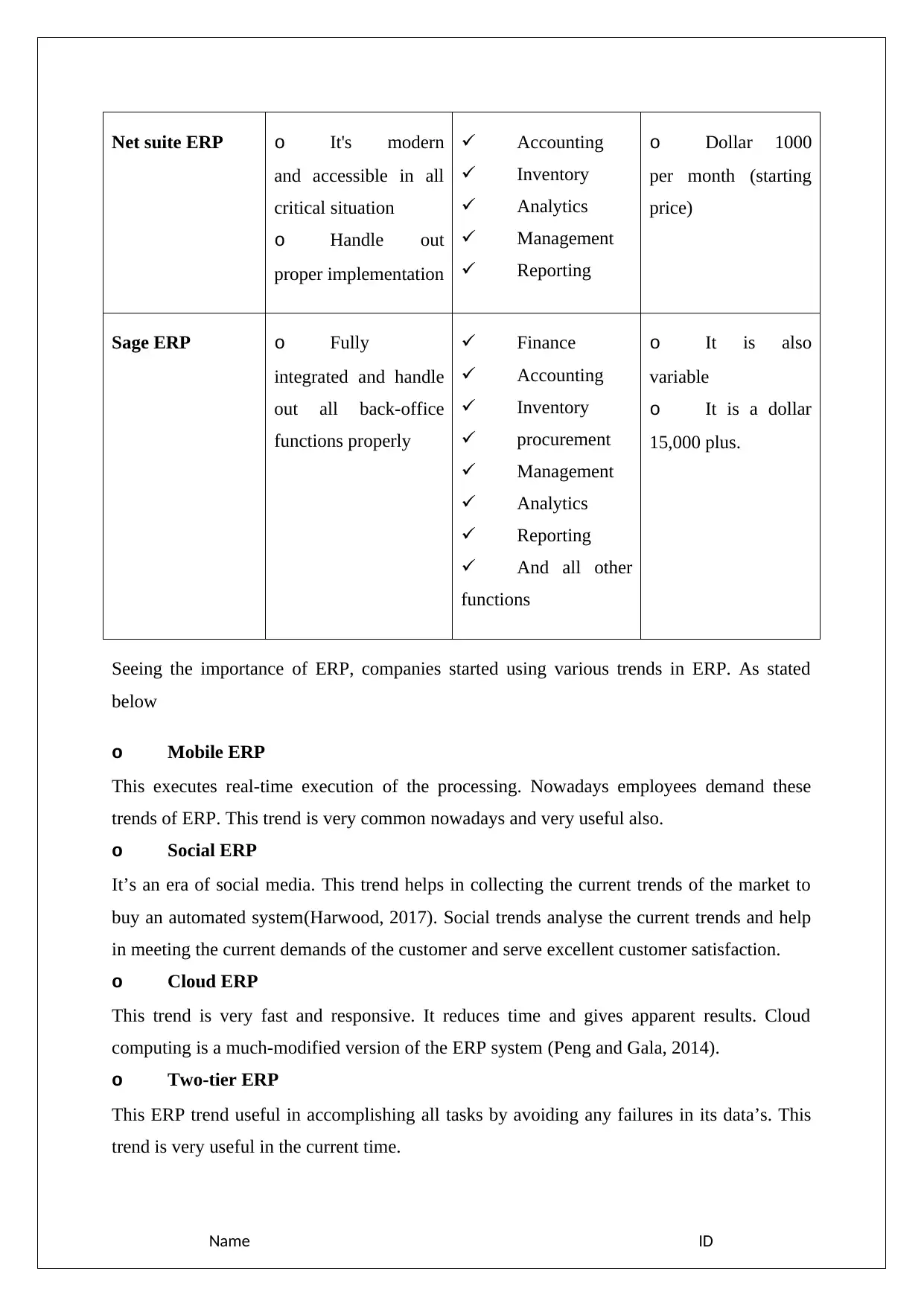
Net suite ERP o It's modern
and accessible in all
critical situation
o Handle out
proper implementation
Accounting
Inventory
Analytics
Management
Reporting
o Dollar 1000
per month (starting
price)
Sage ERP o Fully
integrated and handle
out all back-office
functions properly
Finance
Accounting
Inventory
procurement
Management
Analytics
Reporting
And all other
functions
o It is also
variable
o It is a dollar
15,000 plus.
Seeing the importance of ERP, companies started using various trends in ERP. As stated
below
o Mobile ERP
This executes real-time execution of the processing. Nowadays employees demand these
trends of ERP. This trend is very common nowadays and very useful also.
o Social ERP
It’s an era of social media. This trend helps in collecting the current trends of the market to
buy an automated system(Harwood, 2017). Social trends analyse the current trends and help
in meeting the current demands of the customer and serve excellent customer satisfaction.
o Cloud ERP
This trend is very fast and responsive. It reduces time and gives apparent results. Cloud
computing is a much-modified version of the ERP system (Peng and Gala, 2014).
o Two-tier ERP
This ERP trend useful in accomplishing all tasks by avoiding any failures in its data’s. This
trend is very useful in the current time.
Name ID
and accessible in all
critical situation
o Handle out
proper implementation
Accounting
Inventory
Analytics
Management
Reporting
o Dollar 1000
per month (starting
price)
Sage ERP o Fully
integrated and handle
out all back-office
functions properly
Finance
Accounting
Inventory
procurement
Management
Analytics
Reporting
And all other
functions
o It is also
variable
o It is a dollar
15,000 plus.
Seeing the importance of ERP, companies started using various trends in ERP. As stated
below
o Mobile ERP
This executes real-time execution of the processing. Nowadays employees demand these
trends of ERP. This trend is very common nowadays and very useful also.
o Social ERP
It’s an era of social media. This trend helps in collecting the current trends of the market to
buy an automated system(Harwood, 2017). Social trends analyse the current trends and help
in meeting the current demands of the customer and serve excellent customer satisfaction.
o Cloud ERP
This trend is very fast and responsive. It reduces time and gives apparent results. Cloud
computing is a much-modified version of the ERP system (Peng and Gala, 2014).
o Two-tier ERP
This ERP trend useful in accomplishing all tasks by avoiding any failures in its data’s. This
trend is very useful in the current time.
Name ID
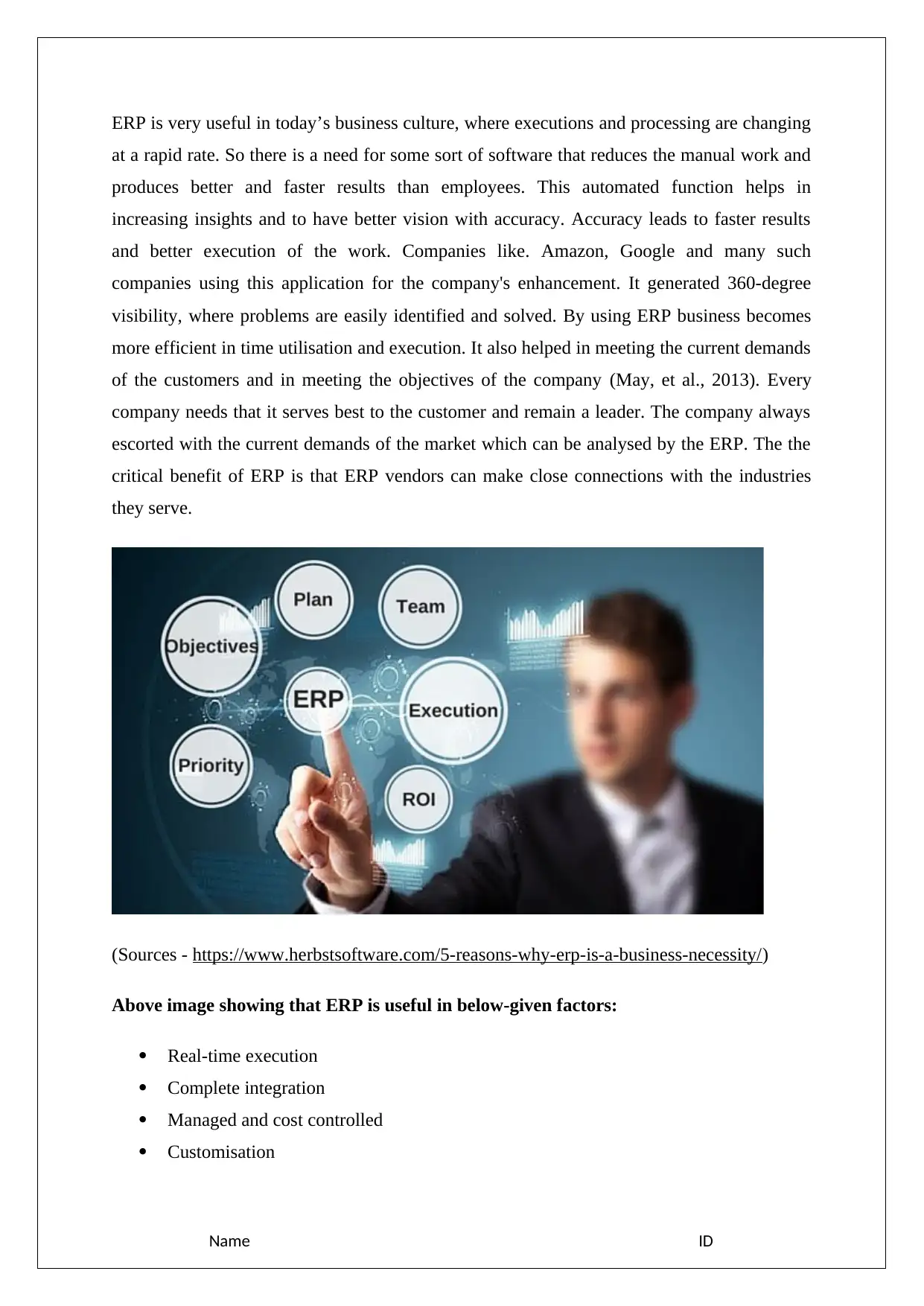
ERP is very useful in today’s business culture, where executions and processing are changing
at a rapid rate. So there is a need for some sort of software that reduces the manual work and
produces better and faster results than employees. This automated function helps in
increasing insights and to have better vision with accuracy. Accuracy leads to faster results
and better execution of the work. Companies like. Amazon, Google and many such
companies using this application for the company's enhancement. It generated 360-degree
visibility, where problems are easily identified and solved. By using ERP business becomes
more efficient in time utilisation and execution. It also helped in meeting the current demands
of the customers and in meeting the objectives of the company (May, et al., 2013). Every
company needs that it serves best to the customer and remain a leader. The company always
escorted with the current demands of the market which can be analysed by the ERP. The the
critical benefit of ERP is that ERP vendors can make close connections with the industries
they serve.
(Sources - https://www.herbstsoftware.com/5-reasons-why-erp-is-a-business-necessity/)
Above image showing that ERP is useful in below-given factors:
Real-time execution
Complete integration
Managed and cost controlled
Customisation
Name ID
at a rapid rate. So there is a need for some sort of software that reduces the manual work and
produces better and faster results than employees. This automated function helps in
increasing insights and to have better vision with accuracy. Accuracy leads to faster results
and better execution of the work. Companies like. Amazon, Google and many such
companies using this application for the company's enhancement. It generated 360-degree
visibility, where problems are easily identified and solved. By using ERP business becomes
more efficient in time utilisation and execution. It also helped in meeting the current demands
of the customers and in meeting the objectives of the company (May, et al., 2013). Every
company needs that it serves best to the customer and remain a leader. The company always
escorted with the current demands of the market which can be analysed by the ERP. The the
critical benefit of ERP is that ERP vendors can make close connections with the industries
they serve.
(Sources - https://www.herbstsoftware.com/5-reasons-why-erp-is-a-business-necessity/)
Above image showing that ERP is useful in below-given factors:
Real-time execution
Complete integration
Managed and cost controlled
Customisation
Name ID
⊘ This is a preview!⊘
Do you want full access?
Subscribe today to unlock all pages.

Trusted by 1+ million students worldwide
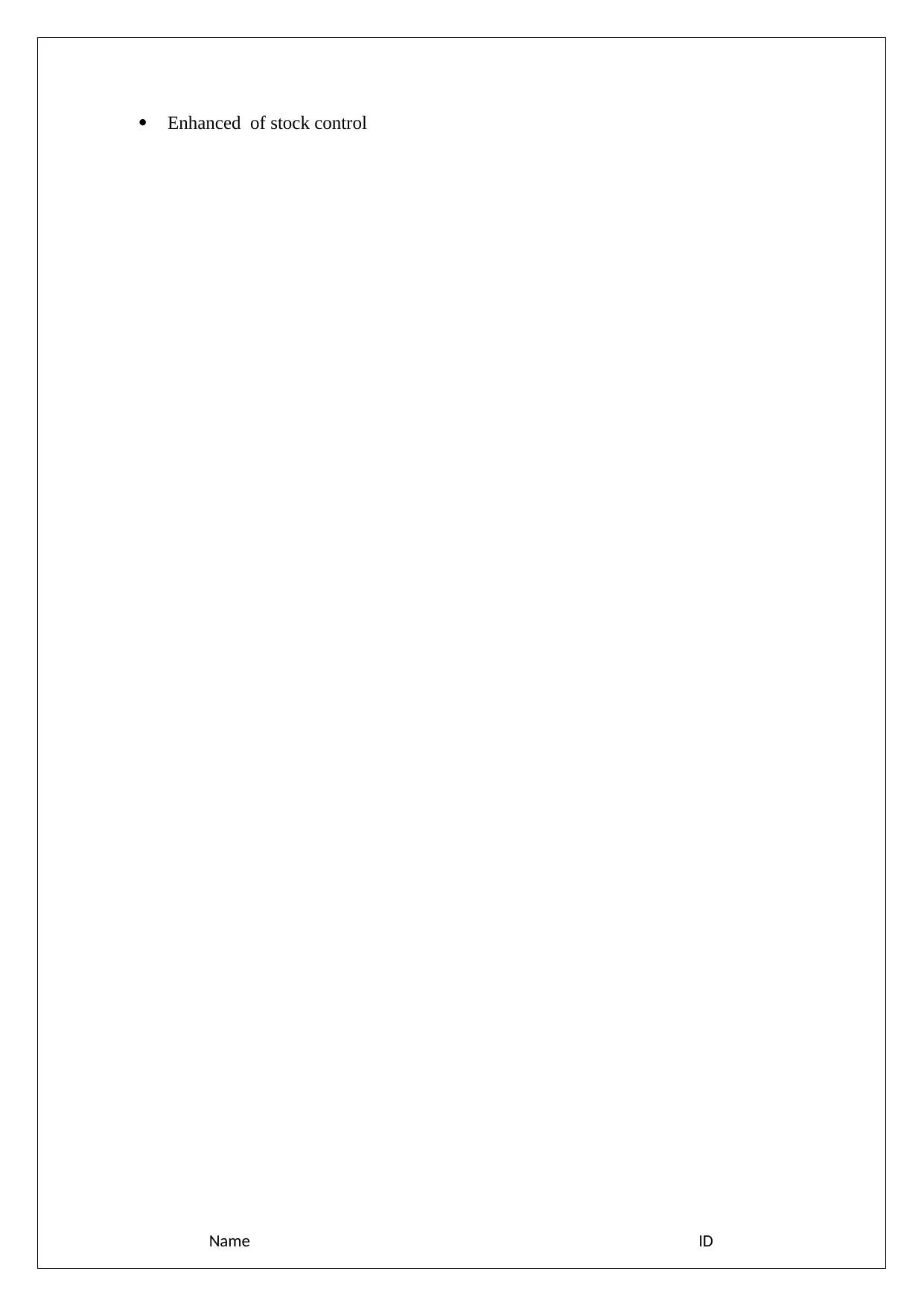
Enhanced of stock control
Name ID
Name ID
Paraphrase This Document
Need a fresh take? Get an instant paraphrase of this document with our AI Paraphraser
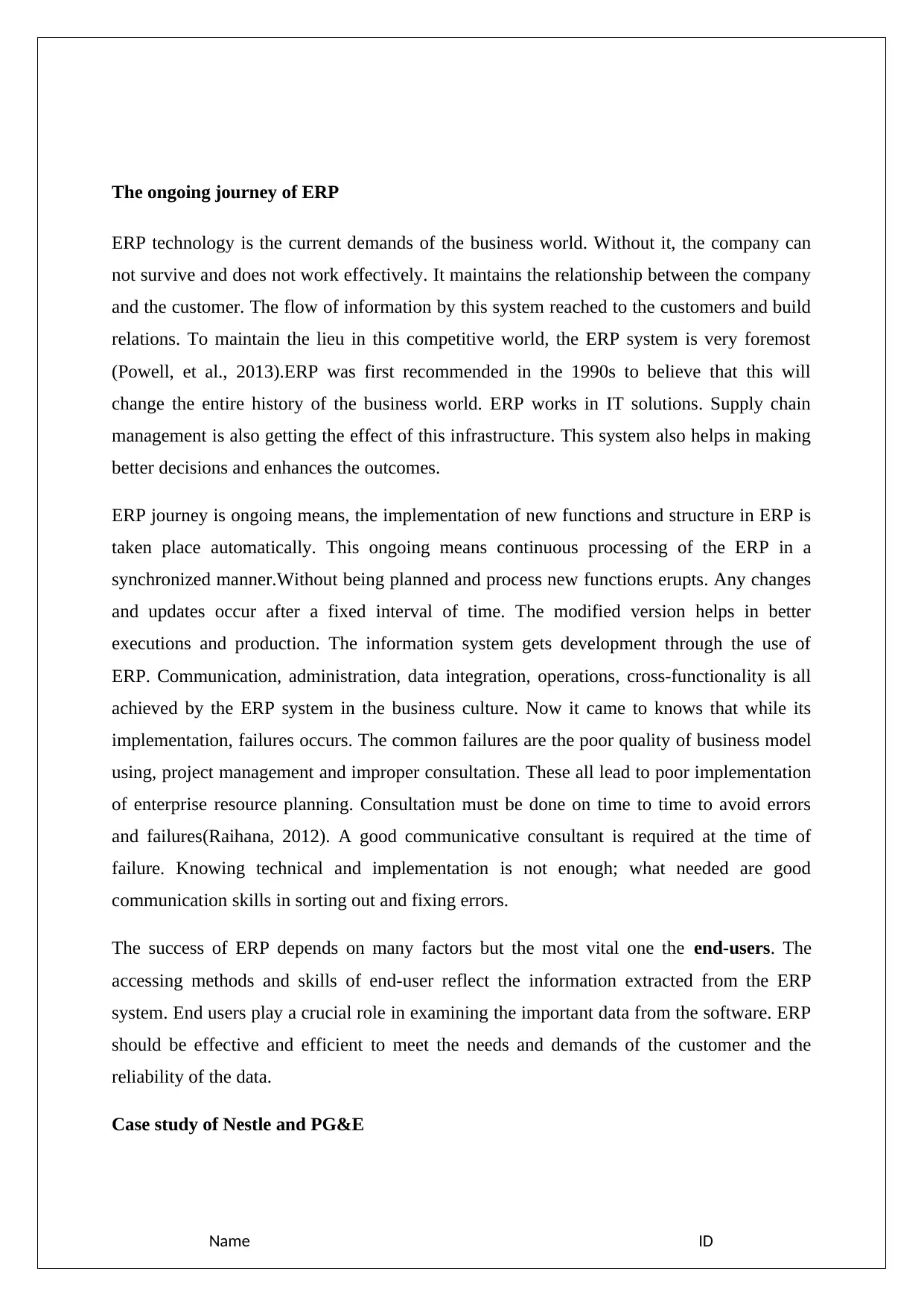
The ongoing journey of ERP
ERP technology is the current demands of the business world. Without it, the company can
not survive and does not work effectively. It maintains the relationship between the company
and the customer. The flow of information by this system reached to the customers and build
relations. To maintain the lieu in this competitive world, the ERP system is very foremost
(Powell, et al., 2013).ERP was first recommended in the 1990s to believe that this will
change the entire history of the business world. ERP works in IT solutions. Supply chain
management is also getting the effect of this infrastructure. This system also helps in making
better decisions and enhances the outcomes.
ERP journey is ongoing means, the implementation of new functions and structure in ERP is
taken place automatically. This ongoing means continuous processing of the ERP in a
synchronized manner.Without being planned and process new functions erupts. Any changes
and updates occur after a fixed interval of time. The modified version helps in better
executions and production. The information system gets development through the use of
ERP. Communication, administration, data integration, operations, cross-functionality is all
achieved by the ERP system in the business culture. Now it came to knows that while its
implementation, failures occurs. The common failures are the poor quality of business model
using, project management and improper consultation. These all lead to poor implementation
of enterprise resource planning. Consultation must be done on time to time to avoid errors
and failures(Raihana, 2012). A good communicative consultant is required at the time of
failure. Knowing technical and implementation is not enough; what needed are good
communication skills in sorting out and fixing errors.
The success of ERP depends on many factors but the most vital one the end-users. The
accessing methods and skills of end-user reflect the information extracted from the ERP
system. End users play a crucial role in examining the important data from the software. ERP
should be effective and efficient to meet the needs and demands of the customer and the
reliability of the data.
Case study of Nestle and PG&E
Name ID
ERP technology is the current demands of the business world. Without it, the company can
not survive and does not work effectively. It maintains the relationship between the company
and the customer. The flow of information by this system reached to the customers and build
relations. To maintain the lieu in this competitive world, the ERP system is very foremost
(Powell, et al., 2013).ERP was first recommended in the 1990s to believe that this will
change the entire history of the business world. ERP works in IT solutions. Supply chain
management is also getting the effect of this infrastructure. This system also helps in making
better decisions and enhances the outcomes.
ERP journey is ongoing means, the implementation of new functions and structure in ERP is
taken place automatically. This ongoing means continuous processing of the ERP in a
synchronized manner.Without being planned and process new functions erupts. Any changes
and updates occur after a fixed interval of time. The modified version helps in better
executions and production. The information system gets development through the use of
ERP. Communication, administration, data integration, operations, cross-functionality is all
achieved by the ERP system in the business culture. Now it came to knows that while its
implementation, failures occurs. The common failures are the poor quality of business model
using, project management and improper consultation. These all lead to poor implementation
of enterprise resource planning. Consultation must be done on time to time to avoid errors
and failures(Raihana, 2012). A good communicative consultant is required at the time of
failure. Knowing technical and implementation is not enough; what needed are good
communication skills in sorting out and fixing errors.
The success of ERP depends on many factors but the most vital one the end-users. The
accessing methods and skills of end-user reflect the information extracted from the ERP
system. End users play a crucial role in examining the important data from the software. ERP
should be effective and efficient to meet the needs and demands of the customer and the
reliability of the data.
Case study of Nestle and PG&E
Name ID
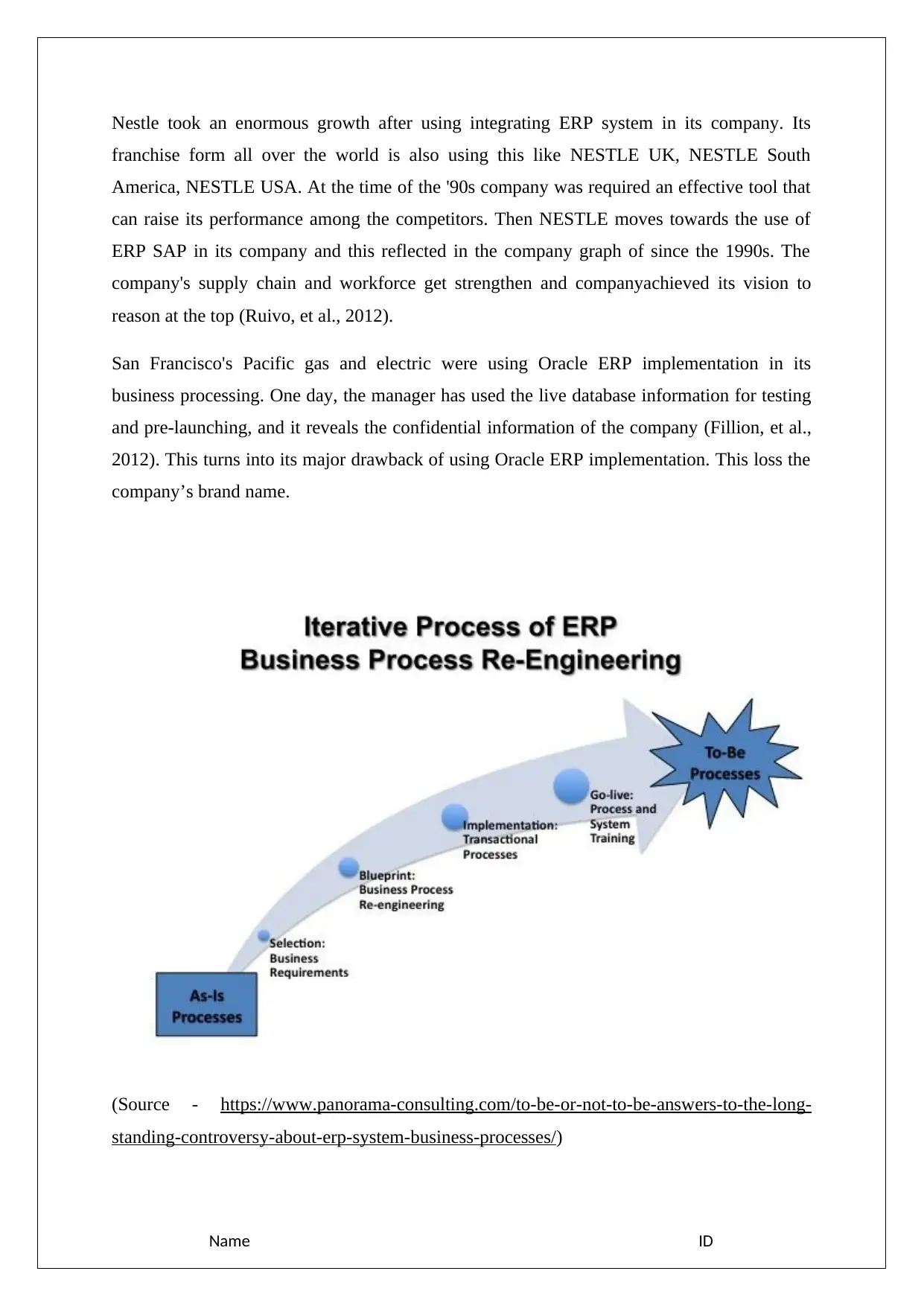
Nestle took an enormous growth after using integrating ERP system in its company. Its
franchise form all over the world is also using this like NESTLE UK, NESTLE South
America, NESTLE USA. At the time of the '90s company was required an effective tool that
can raise its performance among the competitors. Then NESTLE moves towards the use of
ERP SAP in its company and this reflected in the company graph of since the 1990s. The
company's supply chain and workforce get strengthen and companyachieved its vision to
reason at the top (Ruivo, et al., 2012).
San Francisco's Pacific gas and electric were using Oracle ERP implementation in its
business processing. One day, the manager has used the live database information for testing
and pre-launching, and it reveals the confidential information of the company (Fillion, et al.,
2012). This turns into its major drawback of using Oracle ERP implementation. This loss the
company’s brand name.
(Source - https://www.panorama-consulting.com/to-be-or-not-to-be-answers-to-the-long-
standing-controversy-about-erp-system-business-processes/)
Name ID
franchise form all over the world is also using this like NESTLE UK, NESTLE South
America, NESTLE USA. At the time of the '90s company was required an effective tool that
can raise its performance among the competitors. Then NESTLE moves towards the use of
ERP SAP in its company and this reflected in the company graph of since the 1990s. The
company's supply chain and workforce get strengthen and companyachieved its vision to
reason at the top (Ruivo, et al., 2012).
San Francisco's Pacific gas and electric were using Oracle ERP implementation in its
business processing. One day, the manager has used the live database information for testing
and pre-launching, and it reveals the confidential information of the company (Fillion, et al.,
2012). This turns into its major drawback of using Oracle ERP implementation. This loss the
company’s brand name.
(Source - https://www.panorama-consulting.com/to-be-or-not-to-be-answers-to-the-long-
standing-controversy-about-erp-system-business-processes/)
Name ID
⊘ This is a preview!⊘
Do you want full access?
Subscribe today to unlock all pages.

Trusted by 1+ million students worldwide
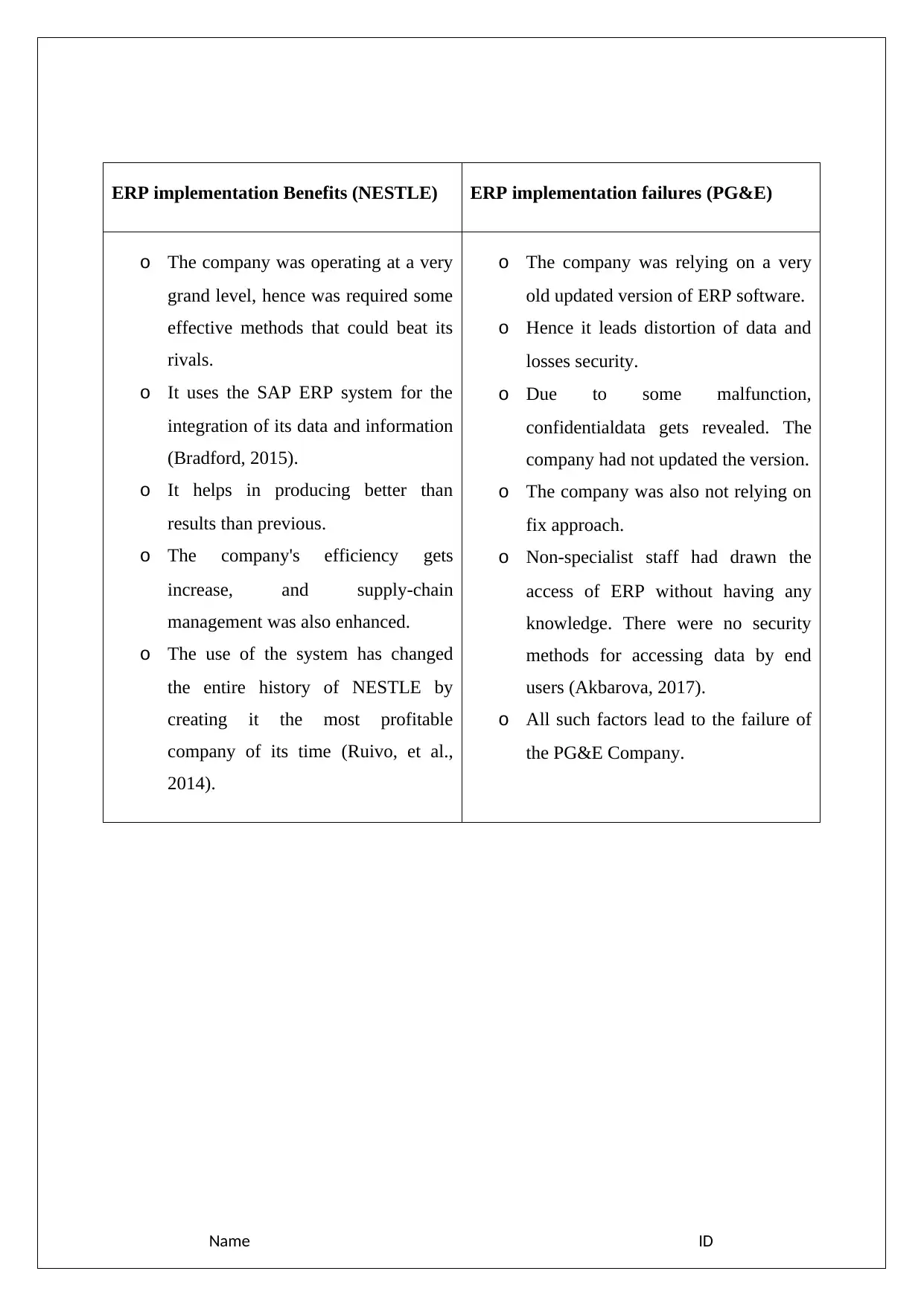
ERP implementation Benefits (NESTLE) ERP implementation failures (PG&E)
o The company was operating at a very
grand level, hence was required some
effective methods that could beat its
rivals.
o It uses the SAP ERP system for the
integration of its data and information
(Bradford, 2015).
o It helps in producing better than
results than previous.
o The company's efficiency gets
increase, and supply-chain
management was also enhanced.
o The use of the system has changed
the entire history of NESTLE by
creating it the most profitable
company of its time (Ruivo, et al.,
2014).
o The company was relying on a very
old updated version of ERP software.
o Hence it leads distortion of data and
losses security.
o Due to some malfunction,
confidentialdata gets revealed. The
company had not updated the version.
o The company was also not relying on
fix approach.
o Non-specialist staff had drawn the
access of ERP without having any
knowledge. There were no security
methods for accessing data by end
users (Akbarova, 2017).
o All such factors lead to the failure of
the PG&E Company.
Name ID
o The company was operating at a very
grand level, hence was required some
effective methods that could beat its
rivals.
o It uses the SAP ERP system for the
integration of its data and information
(Bradford, 2015).
o It helps in producing better than
results than previous.
o The company's efficiency gets
increase, and supply-chain
management was also enhanced.
o The use of the system has changed
the entire history of NESTLE by
creating it the most profitable
company of its time (Ruivo, et al.,
2014).
o The company was relying on a very
old updated version of ERP software.
o Hence it leads distortion of data and
losses security.
o Due to some malfunction,
confidentialdata gets revealed. The
company had not updated the version.
o The company was also not relying on
fix approach.
o Non-specialist staff had drawn the
access of ERP without having any
knowledge. There were no security
methods for accessing data by end
users (Akbarova, 2017).
o All such factors lead to the failure of
the PG&E Company.
Name ID
Paraphrase This Document
Need a fresh take? Get an instant paraphrase of this document with our AI Paraphraser
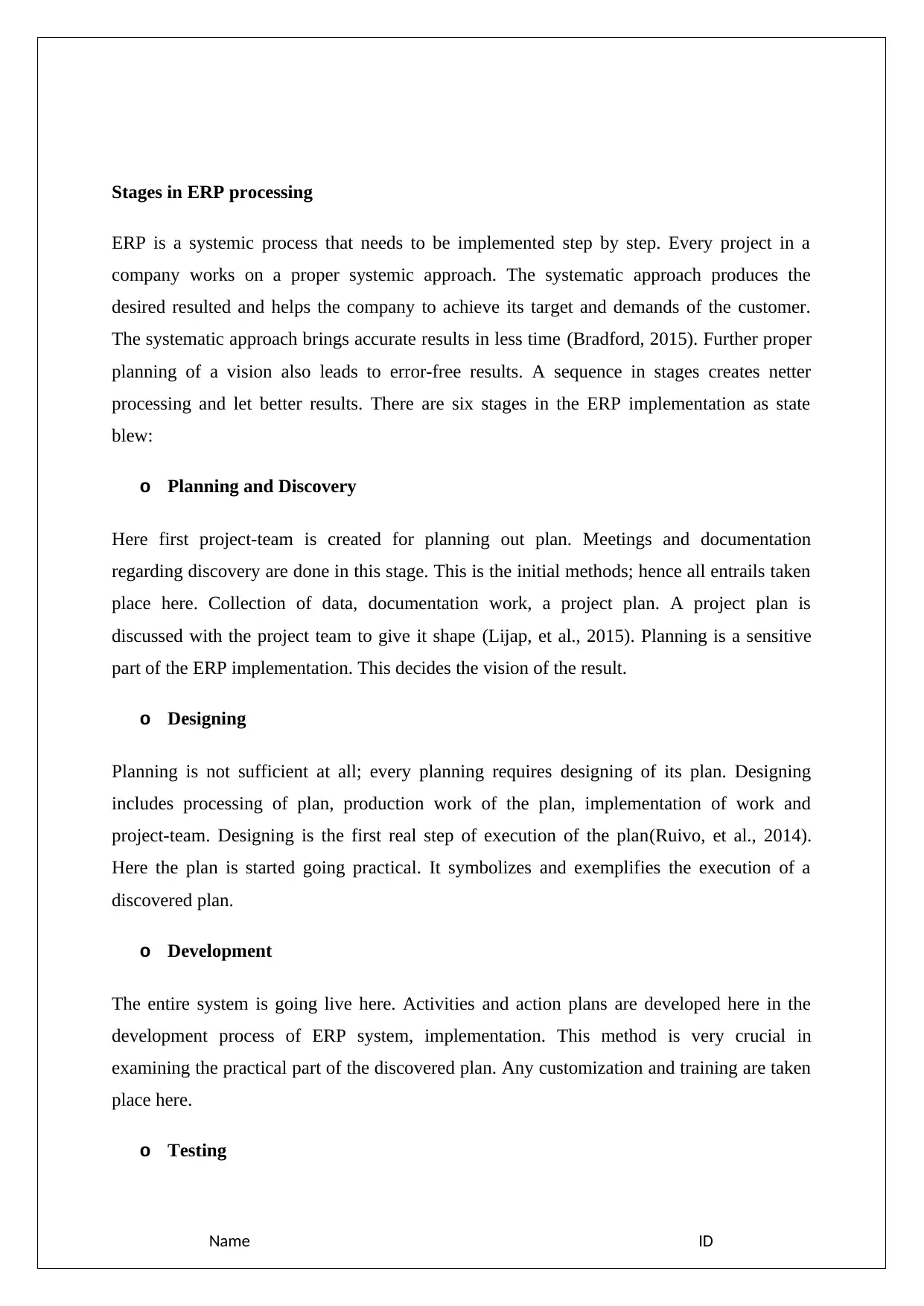
Stages in ERP processing
ERP is a systemic process that needs to be implemented step by step. Every project in a
company works on a proper systemic approach. The systematic approach produces the
desired resulted and helps the company to achieve its target and demands of the customer.
The systematic approach brings accurate results in less time (Bradford, 2015). Further proper
planning of a vision also leads to error-free results. A sequence in stages creates netter
processing and let better results. There are six stages in the ERP implementation as state
blew:
o Planning and Discovery
Here first project-team is created for planning out plan. Meetings and documentation
regarding discovery are done in this stage. This is the initial methods; hence all entrails taken
place here. Collection of data, documentation work, a project plan. A project plan is
discussed with the project team to give it shape (Lijap, et al., 2015). Planning is a sensitive
part of the ERP implementation. This decides the vision of the result.
o Designing
Planning is not sufficient at all; every planning requires designing of its plan. Designing
includes processing of plan, production work of the plan, implementation of work and
project-team. Designing is the first real step of execution of the plan(Ruivo, et al., 2014).
Here the plan is started going practical. It symbolizes and exemplifies the execution of a
discovered plan.
o Development
The entire system is going live here. Activities and action plans are developed here in the
development process of ERP system, implementation. This method is very crucial in
examining the practical part of the discovered plan. Any customization and training are taken
place here.
o Testing
Name ID
ERP is a systemic process that needs to be implemented step by step. Every project in a
company works on a proper systemic approach. The systematic approach produces the
desired resulted and helps the company to achieve its target and demands of the customer.
The systematic approach brings accurate results in less time (Bradford, 2015). Further proper
planning of a vision also leads to error-free results. A sequence in stages creates netter
processing and let better results. There are six stages in the ERP implementation as state
blew:
o Planning and Discovery
Here first project-team is created for planning out plan. Meetings and documentation
regarding discovery are done in this stage. This is the initial methods; hence all entrails taken
place here. Collection of data, documentation work, a project plan. A project plan is
discussed with the project team to give it shape (Lijap, et al., 2015). Planning is a sensitive
part of the ERP implementation. This decides the vision of the result.
o Designing
Planning is not sufficient at all; every planning requires designing of its plan. Designing
includes processing of plan, production work of the plan, implementation of work and
project-team. Designing is the first real step of execution of the plan(Ruivo, et al., 2014).
Here the plan is started going practical. It symbolizes and exemplifies the execution of a
discovered plan.
o Development
The entire system is going live here. Activities and action plans are developed here in the
development process of ERP system, implementation. This method is very crucial in
examining the practical part of the discovered plan. Any customization and training are taken
place here.
o Testing
Name ID
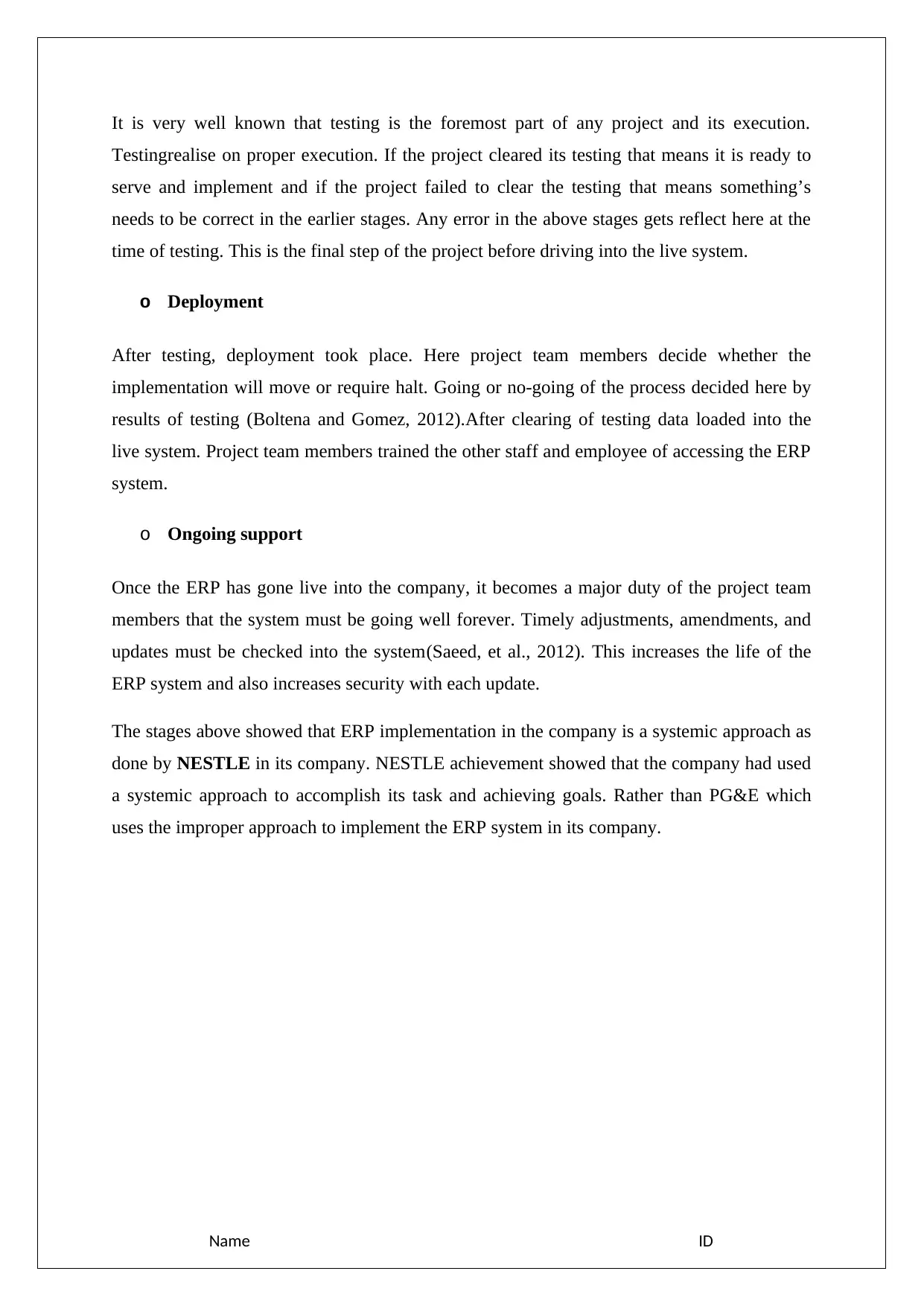
It is very well known that testing is the foremost part of any project and its execution.
Testingrealise on proper execution. If the project cleared its testing that means it is ready to
serve and implement and if the project failed to clear the testing that means something’s
needs to be correct in the earlier stages. Any error in the above stages gets reflect here at the
time of testing. This is the final step of the project before driving into the live system.
o Deployment
After testing, deployment took place. Here project team members decide whether the
implementation will move or require halt. Going or no-going of the process decided here by
results of testing (Boltena and Gomez, 2012).After clearing of testing data loaded into the
live system. Project team members trained the other staff and employee of accessing the ERP
system.
o Ongoing support
Once the ERP has gone live into the company, it becomes a major duty of the project team
members that the system must be going well forever. Timely adjustments, amendments, and
updates must be checked into the system(Saeed, et al., 2012). This increases the life of the
ERP system and also increases security with each update.
The stages above showed that ERP implementation in the company is a systemic approach as
done by NESTLE in its company. NESTLE achievement showed that the company had used
a systemic approach to accomplish its task and achieving goals. Rather than PG&E which
uses the improper approach to implement the ERP system in its company.
Name ID
Testingrealise on proper execution. If the project cleared its testing that means it is ready to
serve and implement and if the project failed to clear the testing that means something’s
needs to be correct in the earlier stages. Any error in the above stages gets reflect here at the
time of testing. This is the final step of the project before driving into the live system.
o Deployment
After testing, deployment took place. Here project team members decide whether the
implementation will move or require halt. Going or no-going of the process decided here by
results of testing (Boltena and Gomez, 2012).After clearing of testing data loaded into the
live system. Project team members trained the other staff and employee of accessing the ERP
system.
o Ongoing support
Once the ERP has gone live into the company, it becomes a major duty of the project team
members that the system must be going well forever. Timely adjustments, amendments, and
updates must be checked into the system(Saeed, et al., 2012). This increases the life of the
ERP system and also increases security with each update.
The stages above showed that ERP implementation in the company is a systemic approach as
done by NESTLE in its company. NESTLE achievement showed that the company had used
a systemic approach to accomplish its task and achieving goals. Rather than PG&E which
uses the improper approach to implement the ERP system in its company.
Name ID
⊘ This is a preview!⊘
Do you want full access?
Subscribe today to unlock all pages.

Trusted by 1+ million students worldwide
1 out of 21
Related Documents
Your All-in-One AI-Powered Toolkit for Academic Success.
+13062052269
info@desklib.com
Available 24*7 on WhatsApp / Email
![[object Object]](/_next/static/media/star-bottom.7253800d.svg)
Unlock your academic potential
Copyright © 2020–2025 A2Z Services. All Rights Reserved. Developed and managed by ZUCOL.



